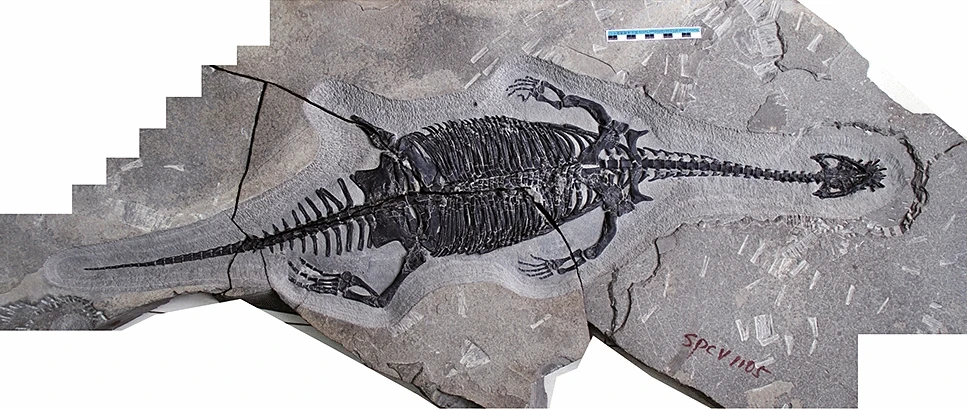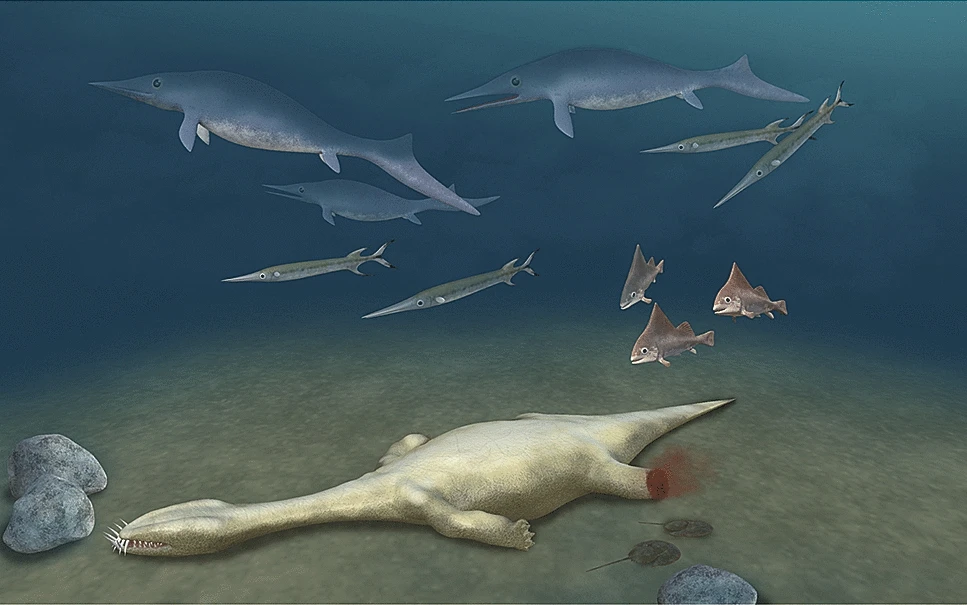An injured pachypleurosaur (Diapsida: Sauropterygia) from the Middle Triassic Luoping Biota indicating predation pressure in the Mesozoic
Liu, Q., Yang, T., Cheng, L., Benton, M.J., Moon, B.C., Yan, C., An, Z. and Tian, L. 2021 An injured pachypleurosaur (Diapsida: Sauropterygia) from the Middle Triassic Luoping Biota indicating predation pressure in the Mesozoic. Scientific Reports 11: 21818 doi:10.1038/s41598-021-01309-z
In this paper I worked with Chinese collaborators mostly based in Wuhan, with Ms Liu Quiling as part of a project supervised by Tian Li and Cheng Long (Liu et al. 2021). We described a new specimen of Diandongosaurus acutidentatus that is much larger than previous examples: over 88 cm compared to around 35 cm for previous specimens (Sato et al. 2014)

Even more interesting is the missing back right leg, which appears to have been bitten off. While there are several examples of predation in the fossil record, evidence remains rare. A recent fossil of a large ichthyosaur showed a nearly-as-large thalattosaur in its stomach (Jiang et al. 2020)—perhaps with bigger eyes than its belly.

As the rest of the specimen is well preserved, it’s likely that this individual managed to get away from whatever was trying to eat it but didn’t seem to last much longer afterwards. This adds more information on the predation pressure in these Middle Triassic oceans, only seven million years after the end-Permian mass extinction. It is by this time that the oceans seem to have become stable enough to support larger and more voracious predators. More evidence was published in December 2021 with a new giant ichthyosaur from the USA (Sander et al. 2021).

This earlier part of the Triassic is showing that there is more exciting evolution going on: rapid evolution of new groups of animals reaching huge body sizes (Sander et al. 2021), new groups taking over and creating new ecological niches (Reeves et al. 2021), and establishing the overall structure of marine ecosystems for the rest of the Mesozoic and even up to the present (Fröbisch et al. 2013).
References
Fröbisch, N. B., Fröbisch, J., Sander, P. M., Schmitz, L. & Rieppel, O. C. 2013. Macropredatory ichthyosaur from the Middle Triassic and the origin of modern trophic networks. Proceedings of the National Academy of Sciences, 110, 1393–1397. doi: 10.1073/pnas.1216750110
Jiang, D.-Y., Motani, R., Tintori, A., Rieppel, O., Ji, C., Zhou, M., Wang, X., Lu, H. & Li, Z.-G. 2020. Evidence supporting predation of 4-m marine reptile by Triassic megapredator. iScience, 23, 101347. doi: 10.1016/j.isci.2020.101347
Liu, Q., Yang, T., Cheng, L., Benton, M. J., Moon, B. C., Yan, C., An, Z. & Tian, L. 2021. An injured pachypleurosaur (Diapsida: Sauropterygia) from the Middle Triassic Luoping Biota indicating predation pressure in the Mesozoic. Scientific Reports, 11, 21818. doi: 10.1038/s41598-021-01309-z
Reeves, J. C., Moon, B. C., Benton, M. J. & Stubbs, T. L. 2021. Evolution of ecospace occupancy by Mesozoic marine tetrapods. Palaeontology, 64, 31–49. doi: 10.1111/pala.12508
Sander, P. M., Griebeler, E. M., Klein, N., Juarbe, J. V., Wintrich, T., Revell, L. J. & Schmitz, L. 2021. Early giant reveals faster evolution of large body size in ichthyosaurs than in cetaceans. Science. doi: 10.1126/science.abf5787
Sato, T., Cheng, Y.-N., Wu, X.-C. & Shan, H.-Y. 2014. Diandongosaurus acutidentatus Shang, Wu & Li, 2011 (Diapsida: Sauropterygia) and the relationships of Chinese eosauropterygians. Geological Magazine, 151, 121–133. doi: 10.1017/S0016756813000356
